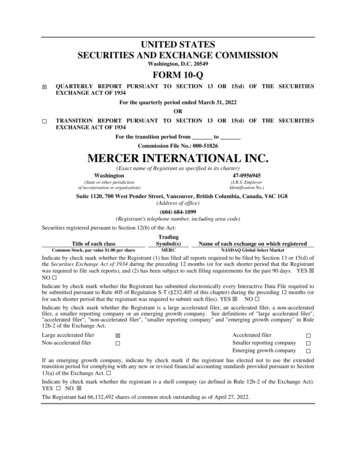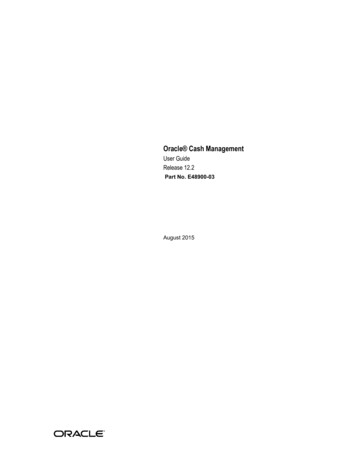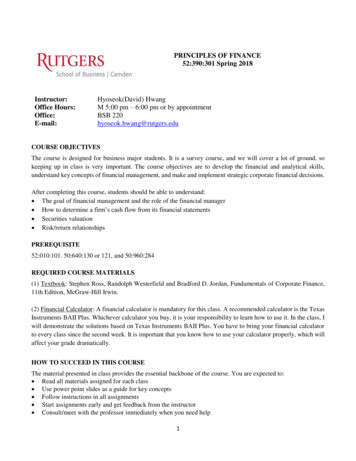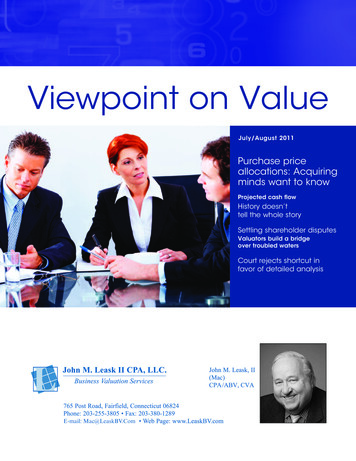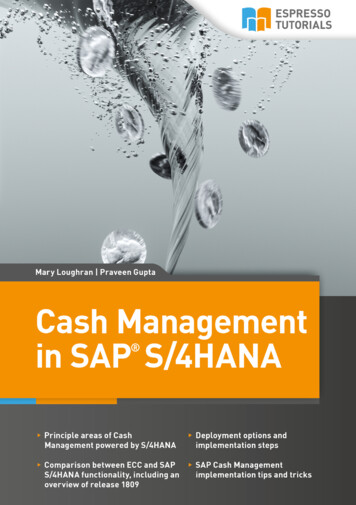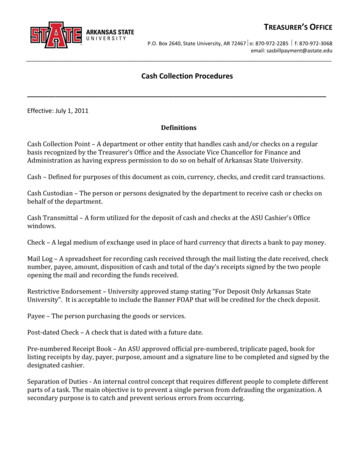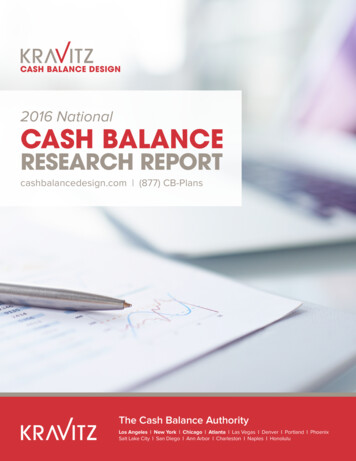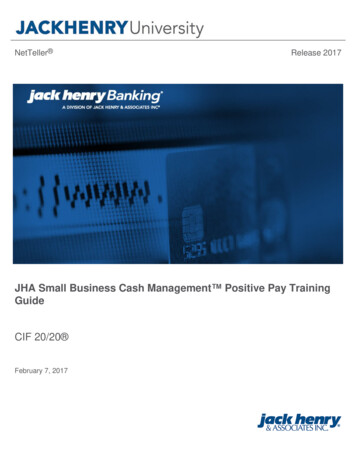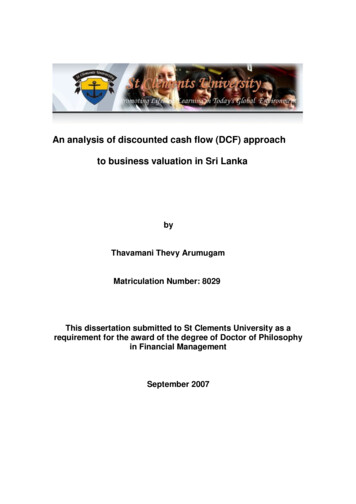
Transcription
An analysis of discounted cash flow (DCF) approachto business valuation in Sri LankabyThavamani Thevy ArumugamMatriculation Number: 8029This dissertation submitted to St Clements University as arequirement for the award of the degree of Doctor of Philosophyin Financial ManagementSeptember 2007
Table of ContentsChapter 1 Introduction .51.1 Background.51.1.1 wealth maximization .51.2 Concept of an investment .61.3 Future/Present value of money .71.4 Discounted cash flow (DCF).81.4.1 History of discounted cash flow (DCF) .91.5 Risk in context . 101.6 Valuation of a business. 121.7 Problem discussion. 131.7.1 Why do these valuations differ? . 131.7.2 How does one know which of these values is the most accurate?. 131.8 Purpose. 151.9 Previous research and potential contribution. 161.10 Industry and economic background. 17Chapter 2 Literature review . 222.1 The investment process . 222.2 Risk attitude and perspective . 232.2.1 Fundamentals of risk management. 232.2.2 An approach to risk management. 252.3 Valuation . 272.3.1 Why is business valuation important?. 272.4 Valuation models. 272.5 Asset based valuation . 282.5.1 Value of assets. 292.5.2 Liabilities . 302.6 Absolute valuation or discounted cash flow (DCF) models. 302.6.1 Incorporate financial and non-financial performance data . 332.6.2 Free cash flow (FCF) discount models . 352.6.3 Calculating the terminal value. 422.6.4 Calculating the discount rate. 432.6.5 Country risk and cost of capital. 482.6.6 Calculating total enterprise value (EV). 542.6.7 Calculating the value of equity (Ve) . 552.6.8 How do the analysts value a business that is losing money?. 552.6.9 Pros and cons of discounted cash flow DCF. 57
2.6.10 Summary. 582.7 Discounted dividend model. 582.8 Relative valuation . 602.8.1 First principles: . 602.8.2 What is relative valuation?. 622.8.3 Reasons for popularity . 622.8.4 Potential pitfalls . 632.9 Reconciling relative and discounted cash flow valuations . 63Chapter 3 Methodology . 653.0 Method approaches. 653.1 Inductive or deductive approach. 653.2 Quantitative and qualitative approach. 653.3 Research approach. 663.4 Research design. 663.5 Data collection methods . 673.5.1 Sample . 673.6 Modes of data collection . 673.6.1 Advantages of questionnaire . 683.6.2 Disadvantages of questionnaire . 683.7 Deductive approach. 683.8 After the interviews, the following steps were taken: . 713.9 Reliability and validity of the data . 713.10 Statement of hypothesis. 723.11 Statistical techniques used in the analysis . 723.12 Summary . 72Chapter 4 Results and discussion . 734.0 Introduction. 734.1 Descriptions of participants . 734.2 Participants’ views . 734.2.1 Valuation techniques. 744.2.2 SWOT analysis. 754.2.3 Financial forecasts. 764.2.4 Terminal value. 784.2.5 Cost of debt . 804.2.6 Risk free rate. 814.2.7 Risk premium . 814.2.8 Beta estimate. 824.2.9 Cost of equity. 834.2.10 Discount rate. 844.2.11 Responses to open questions. 844.3 Inferential statistics . 95
4.3.1 Tables 1 (r) to v (r) . 974.4 Analysis of hypothesis. 1014.5 Discussions . 1024.5.1 Risk and uncertainty. 1074.5.2 Valuation of businesses under distress. 1124.5.3 Adapting discounted cash flow valuation to distress situations 1144.5.4 Valuing high growth businesses. 119Chapter 5 Recommendations and implications . 1255.1 Introduction. 1255.2 Summary . 1255.3 Recommendations. 1275.4 Conclusion. 1355.5 Further research . 137Appendices. 138Glossary. 138Questionnaire . 290
Chapter 1 Introduction1.1 BackgroundFinancial management is broadly concerned with the acquisition and use offunds by a firm. Corporate finance theory has developed around a goal ofshareholder wealth maximization.Evolution of the corporate financial objective:Until 1921, the firms did not see any need for stating financial objectives. Thecorporate financial objective since then has grown into three phases. Profit maximization objective Social responsibility of business Shareholder wealth maximizationDuring the time of debate on the social responsibility of business, a fewresearchers and thinkers put forward various arguments. That was essentially astruggle for developing a more acceptable objective statement with time;shareholder wealth maximization and shareholder value became universallyaccepted financial statements for businesses.1.1.1 Wealth maximizationThe debate around ‘profit maximization’ and ‘social responsibility’ led to finding amore logical expression of corporate objectives. This pursuit led to the theory ofshareholder wealth maximization. David Durand and Lutz (1952) introduced theconcept of shareholder wealth maximization. They observed that the goals ofprofit maximization as well as wealth maximization are consistent with each otheronly under two conditions:(1) Investment takes place in tiny increments and(2) Where there is certainty in getting the return on investment
The wealth maximization goal is based on discounting, while putting forth ismacro-economic theory of interest introduced by Alfred Marshall in 1930. Keynesused the discounting factor in 1936 in his concept of marginal efficiency ofcapital.The shareholders’ wealth maximization goal, thus, reflects the magnitude, timingand risk associated with the cash flows expected to be received in the future byshareholders.1.2 Concept of an investmentAn investment is the outlay of a sum of money in the expectation of a futurereturn. This compensates for the original outlay as well as to cover the inflation,interest foregone and risk. An investment today will determine the firm’s strategicposition many years hence.Capital budgeting is primarily concerned with sizable investments in long-termassets. These assets may be tangible items such as property, plant & machineryor intangible ones such as new technology, patents or trademarks. Investmentsin processes such as research, design, development and testing through whichnew technology and new products are created may also be viewed asinvestments in intangible assets.Firms operate in a dynamic environment therefore; they must continually makechanges in different areas of their operations in order to meet the challenges ofthe changing environment. The strategic need of the firm will determine amongstother things which investment meet the strategic objectivity. By analysing thestrengths, weaknesses, opportunities and threats (SWOT) of the firm andexternal factors such as political, economical, social and technological (PEST)affecting the firm the management will be able to come to an optimal decision.
The net benefits of investment depend upon the quality of investment decisions.The quality is judged through the weighing of benefits against the risks anduncertainties. The net benefit of the project will be a function of(a) The risks involved (b) the ability to generate synergy, and (c) the firm’sinternal control and pro-activeness.1.3 Future/Present value of moneyInvestment, financing and dividend decisions have significant impact on the firm’svaluation. A key concept underlying valuation is the value of money based ontime.Money has time value. An investment of one rupee today would grow to (1 r) ayear hence. (r is the rate of return earned on the investment)In an inflationary period, a rupee today represents a greater real purchasingpower than a rupee a year hence. This is due to opportunity cost and risk overtime.Many financial problems involve cash flows occurring at different points of time.For evaluating such cash flows, an explicit consideration of time value of moneyis required. The value of the present investment on a future date to the timevalue of money is called the future value of money.The concept of discounting is the reverse of compounding; using thecompounding process, the future value of today’s money can be found at a givenrate of interest. By discounting, the present value of a future cash flow can befound. The formula for discounting can be obtained by interchanging the sides ofthe compounding formula.
The general value for the future value of a single amount is given by the equationFVn PV (1 r)nPV FVn / (1 r)nWhere:FVn- future value n years hencePV- present valuer- interest rate per annumn- number of years for which compounding is done1.4 Discounted cash flow (DCF)Discounted cash flow (DCF) is a cash flow summary that it has to be adjusted toreflect the present value of money. Discounted cash flow (DCF) analysisidentifies the present value of an individual asset or portfolio of assets. This isequal to the discounted value of expected net future cash flows, with the discountreflecting the cost of waiting, risk and expected future inflation. Discounted cashflow (DCF) analysis is applied to investment project appraisal and corporatevaluation.By combining assessments of both opportunity cost and risk, a discount rate iscalculated for the analysis of present value of anticipated future cash flows. Freecash flow is the remaining amount of operating cash flow for the shareholders,after covering investments in fixed assets and working capital needs (WCN).Free cash flow is important because it allows a business to pursue opportunitiesthat enhance shareholder value. One key measure of the value of a firm’s equityis considered the present value of all free cash flows. Opportunity cost issignificant because any financial decision must be measured against a defaultlow-risk investment alternative or the inflation rate.Risk becomes a significant factor when the financial decision being consideredinvolves some statistically significant probability of loss. Calculation of risk factors
beyond opportunity cost can often be very complex and imprecise, requiring theuse of actuarial analysis methods and in-depth market analysis. When risk isincluded in discounted cash flow (DCF) analysis it is generally done so accordingto the premise that investments should compensate the investor in proportion tothe magnitude of the risk taken by investing. A large risk should have a highprobability of producing a large return or it is not justifiable.1.4.1 History of discounted cash flow (DCF)Following the stock market crash of 1929, discounted cash flow (DCF) analysisgained popularity as a valuation method for stocks. Irving Fisher in his 1930book, ”The Theory of Interest” and John Burr William’s 1938 text ‘The Theory ofInvestment Value’ first formally expressed the discounted cash flow DCF methodin modern economic terms.Later Gordon (1962) extended the William model by introducing a dividendgrowth component in the late 1950’s and early 1960’s. The dividend DIVcontinues to be widely used to estimate the value of stock.In recent years, the literature for estimating the value of a firm and the value ofequity has been expanded dramatically. Copeland, Koller and Murrin (1990,1994,2000), Rappaport (1988, 1998), Stewart (1991), and Hackel and Livnat (1992)were current pioneers in modelling the free cash flow to the firm, which is widelyused to derive the value of the firm.Recently, Copeland, Koller and Murrin (1994) and Damodaran (1998) introducedan equity valuation model based on discounting a stream of free cash flows toequity at a required rate of return to shareholders. In addition, Damodaran (2001)provides several approaches to estimate the value of a firm for which there areno comparable companies, no operate earnings and a limited amount of cashflow data. Fama’s (1970) efficient market research challenged the validity ofintrinsic valuation models.
1.5 Risk in contextToday world is in a social and political uncertainty. Globalisation is a major factorin business. The business environment is no longer limited to the country whereit operates. Competition for today’s businesses can come from all the countriesaround the globe. Today’s management teams in order to work efficiently andeffectively to cope up with the dynamic change environment need to better,faster, leaner and quicker on their feet than ever before.The pace of technological change suggests that this is likely to continue wellbeyond the near future and it is clear that standing still is not an option. Onlythose organisations that adapt well will prosper; change management becomesboth a business necessity and an art. The true measure of a business success isthe rate at which it can improve its range of products, services and the way itproduces and delivers them.The reason why risk is so difficult to determine is the varied and uncertain extentto which business players’ act to influence the outcome. Risk may be defined asuncertainty about a possible future change, either beneficial or adverse. It ishowever different to uncertainty since it can be predicted on a mathematicalbasis whereas uncertainty cannot.The term risk management is applied in a number of diverse disciplines. Toomany social analysts, politicians and academics it is the management ofenvironmental and nuclear risks, those technology generated macro risks thatappear to threaten our existence.To bankers and financial officers it is the sophisticated use of such techniques ascurrency hedging and interest rate swaps. To insured buyers and sellers it iscoordination of insurable risks and the reduction of insurance costs. To hospitaladministers it may mean quality assurance. To safety professionals it is reducingaccidents and injuries.
Risk management is a discipline for living with the possibility that future even tomay cause adverse effects. Risk management means a course of action plannedto reduce the risk of an event occurring and minimizing or containing theconsequential effects should that event occur. In order to achieve this, a riskmanagement policy should be put in place.Risk management involves the identification, measurement and economic controlof risks and developing strategies to manage the risk that threaten the assetsand earnings of the institution. The management of any loss-producing event,which occurs pre-emergency, emergency handling and recovery, is contingencyplanning, whereas the process of restoring operations and minimising the lossassociated with an occurrence is disaster recovery.In ideal risk management, a prioritisation process is followed whereby the riskswith the greatest loss and the greatest probability of occurring are handled first,and risks with lower probability of occurrence and lower loss are handled later. Inpractice, the process can be very difficult when balancing between risks.Risk management also faces a difficulty in allocating resources properly. This isthe idea of opportunity cost. Resources spent on risk management could beinstead spent on activities that are more profitable. Again, ideal risk managementspends the least amount of resources in the process while reducing the effects ofrisks as much as possible.Learn from your mistakes is an admonition for losers. Successful people learnfrom others’ mistakes and thereby avoid their own. As business becomeincreasingly complex, it is becoming more difficult for CEOs to know whatproblems might lie in wait. Therefore, they need someone systematically to lookfor potential problems to design safeguards in order to minimise potentialdamage. In any event, risk management is becoming increasingly important.
Risk management is seen as the answer for developing the business ability toanticipate the unexpected. Businesses can identify and analyse the risk and thencan use their core competences to manage them. Businesses can turnaroundplenty of threats into opportunities if they really assess the risks better than theirrivals do.Risk management should not be looked at another task for today’s businessplayers to fit into an already overcrowded business schedule. Businesses have toadapt ways of prioritising the schedule, deploying people and capital moreproductively. The important issue is to focus on the uncertainties of future and tobe able to identify and handle them. Risk management can help to ensure thatthey reach the successful goal eventually.1.6 Valuation of a businessA business valuation is the process of determining the intrinsic value of commonstock. The valuation process includes understanding the business, analysing theindustry, determining a methodology and generating a report.In a globalise dynamic business world, valuation is gaining momentum inemerging markets for mergers, acquisitions, joint ventures, restructuring and thebasic task of running businesses to create value. Yet valuation is much moredifficult in these environments because buyers and sellers face greater risks andobstacles than they do in developed countries.In 1997, the risks and obstacles had been so serious in the emerging markets ofEast Asia. This Asian financial crisis weakened a mass of companies and banksand led to a surge in merger and acquisition activity, giving valuation practitionersa good chance to test their skills. The findings of valuation of companies inemerging markets clearly suggest that market prices for equities do not take intoaccount the commonly expected country risk premium. If these premiums wereincluded in the cost of capital, the valuation would be 50 to 90 percent lower than
the market values. (Asian Development Outlook 2000, Asian Development Bankand Oxford University Press, p. 32)In order for the stock market to function, a belief in valuation techniques ofindividual firms is necessary. Without a valuation model to estimate value,investors would not be able to arrive at conclusions on what price to buy or sellan asset. When inspecting different analysts’ results of specific businessvaluation, the value often differs.1.7 Problem discussion1.7.1 Why do these valuations differ?This is because different valuation techniques used by different analysts and theinputs plugged into the valuation techniques differ between the analysts. Sincethe analysts have diverse views of the future of the business, their forecasts willdiffer, hence the recommended values differ.1.7.2 How does one know which of these values is the mostaccurate?It is not possible to determine the correct value because of risks anduncertainties involved in carrying out businesses. Therefore, a present needs toimprove the tools used by analysts in valuing their businesses.In order to understand valuation, two main concepts of value must beunderstood.First, the commonly accepted theoretical principle to value anyfinancial asset is the discounted cash flow (DCF) methodology. An asset is worththe amount of all future cash flows to the owner of this asset discounted at anopportunity rate that reflects the risk of the investment. This fundamentalprinciple does not change and is valid through time and geography. A valuationmodel that best converts this theoretical principle into practice should be themost useful.
Based on the first concept, the second concept states that valuation is aninherently forward looking in a business. Valuation requires an estimate of thepresent value of all expected future cash flows to shareholders. In other words, itinvolves looking into an uncertain future and making an educated guess aboutthe many factors determining future cash flows. Since the future is uncertain,intrinsic value estimates will always be subjective and imprecise. Better modelsand superior estimation techniques may reduce the degree of inaccuracy, but novaluation technique can be expected to deliver a single correct intrinsic valuemeasure.These main concepts illustrate that there are few things more complex than thevaluation of businesses. Thousands of variables affect the future cash flows of acompany and thus the value of a business. Most variables are known, but veryfew are understood; they are independent and related, they are measurable, butnot necessarily quantitative and they affect business values alone and incombination.A continuous need is to improve the tools used by analysts when valuing firms.This dissertation aims to contribute to the continuous process. There are severalopinions on what creates value in a business. Therefore, there are differentapproaches to estimate the value of a firm. It is a huge task to do research on allapproaches. In this dissertation, a brief discussion was made on selected corevalue techniques and the focus is on discounted cash flow (DCF) value modelapproach.Discounted cash flow (DCF) method is the mostly used fundamental method inbusiness valuation (Perrakis, 1999), consequently the basic problem that thisstudy is faced with is; how can improvements to the discounted cash flow (DCF)model, as it is used to value firms, be achieved?
In order to show how analysts can improve the way they apply the discountedcash flow (DCF) model and how they report their results, thorough understandingof the discounted cash flow (DCF) model and the context in which it is used isnecessary. In order to achieve this, analyst has to ask the question; what are theweaknesses and limitations of the discounted cash flow (DCF) model. Thediscounted cash flow (DCF) method is used as a management tool in decisionmaking of the businesses.The discounted cash flow (DCF) model depends on two inputs; the numerator,which is an estimated future cash flow and the denominator i.e. discount rate(weighted average cost of capital). The output of the model is dependent onthese two inputs. How to calculate the denominator are the major concern ofsome scientific reports (Bohlin, 1995) as well as the topic of large discussions infinancial text. (Copeland, 2001, Perrakis, 1991 and Ross, 1991)To summarise the problem discussion; the thesis is conducted in order to findreasons behind problem areas in the discounted cash flow (DCF) approach tofirm valuation, as well as how improvements can be made to these areas.This will be accomplished by conducting,1) A literature study of related academic theories, mathematical models ingeneral, the discounted cash flow (DCF) model in particular, forecastingmodels of revenue, risks, uncertainties involved, cost of capital, discountrate to be used on the free cash flows in order to project the presentvalues.2) Questionnaire survey and personal interviews of 63 organisations1.8 PurposeThe purpose of this study is to analyse the theories and examine the approachesof business valuation models. Identifying the key inputs used in the valuationmodels, and then to find out the methods of forecasting these inputs with greater
degree of accuracy. This will be accomplished by a literature study and asubsequent questionnaire survey.The purpose of the literature study is to analyse the use of the discounted cashflow method as it is used in firm valuation. The aim is to probe into theweaknesses of the method and the reasons behind the problem areas. Further,the study will be conducted to find reasons and arguments to solutions of theseproblemsThe purpose of the subsequent questionnaire survey is to prove whether the nullhypothesis is true or false and to expose important implications of empiricalweaknesses and limitations of the discounted cash flow (DCF) model.The null hypothesis H0 states that the different techniques of valuation ofbusinesses will produce the same results.The alternate hypothesis H1 assumes that different techniques of valuation ofbusine
flow (DCF) analysis is applied to investment project appraisal and corporate valuation. By combining assessments of both opportunity cost and risk, a discount rate is calculated for the analysis of present value of anticipated future cash flows. Free cash flow is the remaining amount of operating cash flow for the shareholders,
